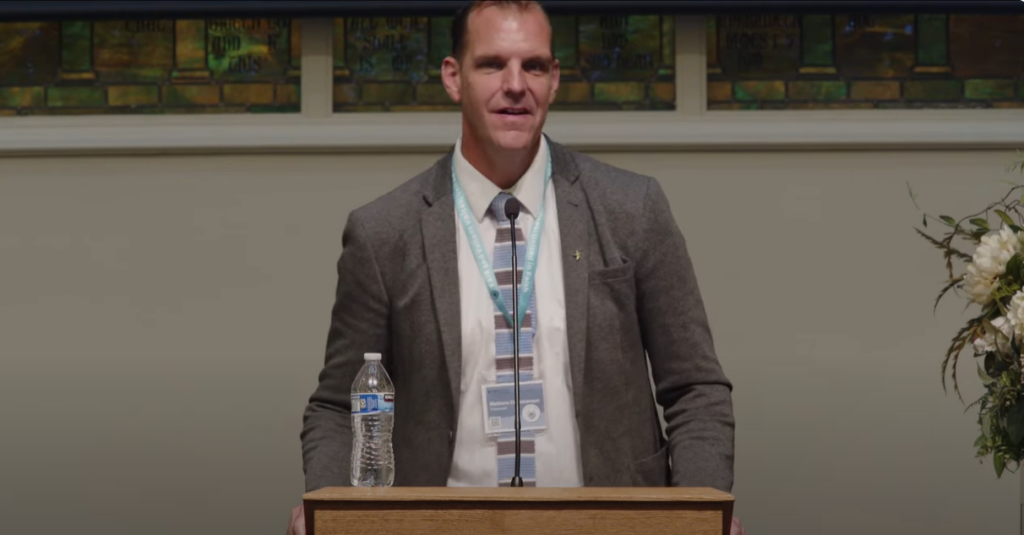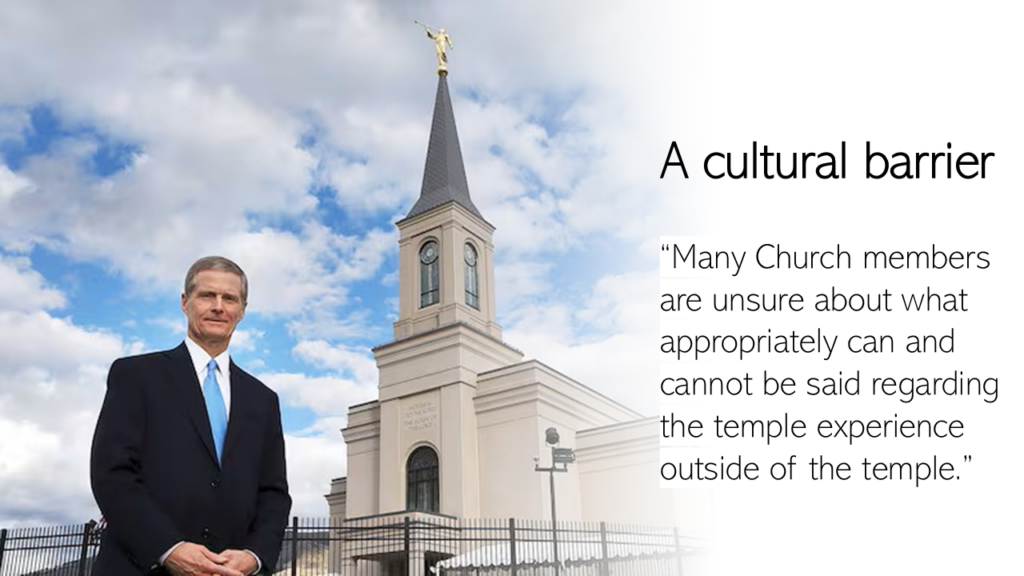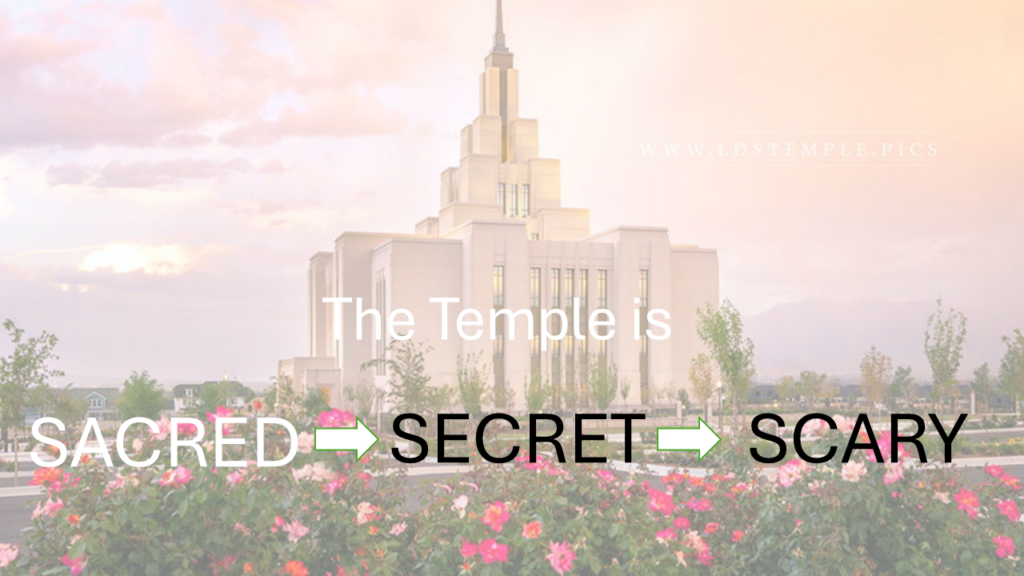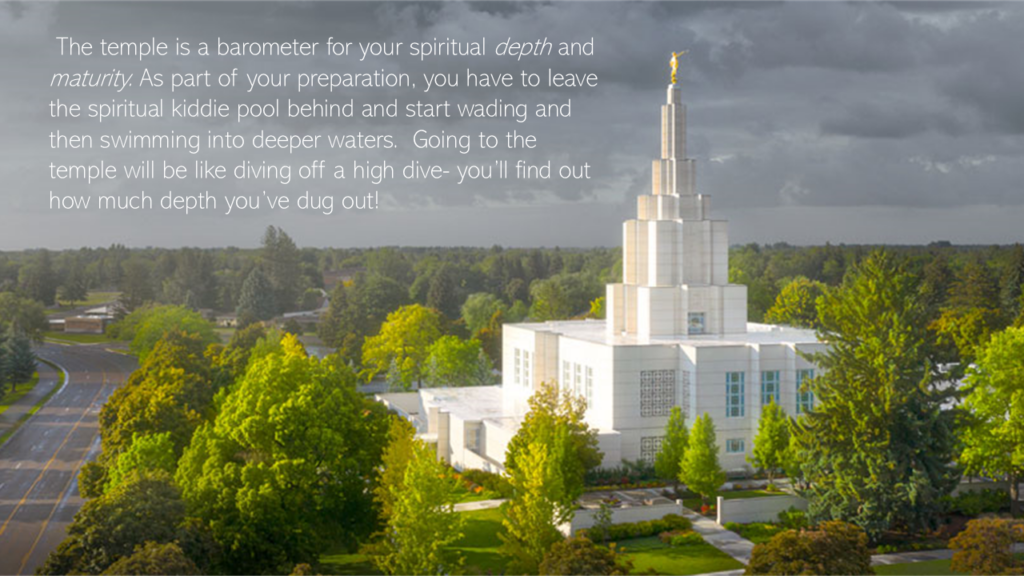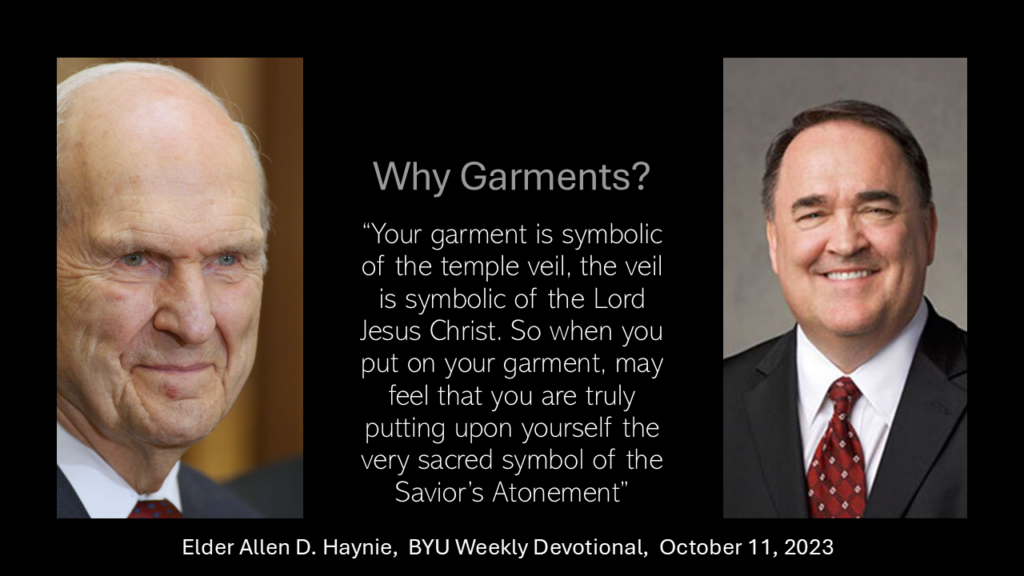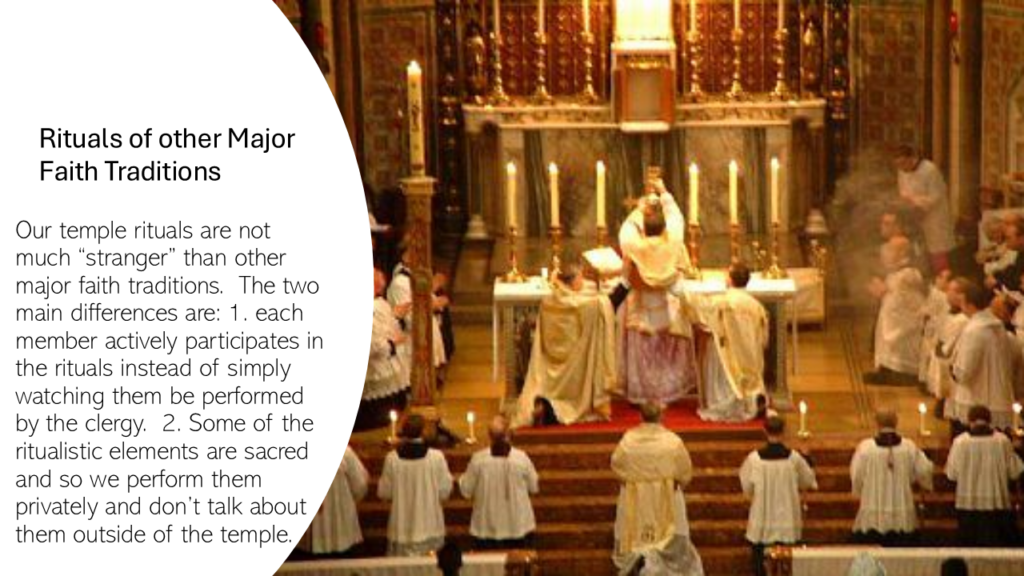Matt Christiansen’s talk focuses on preparing today’s youth for meaningful temple experiences by fostering spiritual depth, understanding sacred rituals, and emphasizing the importance of home-centered temple preparation. Through personal stories, scriptural insights, and relatable analogies, he highlights how temple worship can transform lives and deepen faith in Jesus Christ.
This talk was given at the 2024 FAIR Conference “FAIR and Valiant Voices”, on the campus of the American Heritage School in Salt Lake City, Utah, on August 8, 2024.

Matt Christiansen has dedicated the past 25 years to teaching the gospel of Jesus Christ, first as a missionary in Romania and now as a Seminary and Institute teacher committed to helping today’s youth develop lasting faith.
Transcript
Introduction by Scott Gordon:
So our next speaker, Matt Christiansen, has got an outstanding bio you might want to take a look at on Whova. He spends his time as a Seminary and Institute teacher and likes to try to get people to stop looking at their phones so much and actually listen to the principles of the gospel. Hopefully, he’ll do that for us here as well. So with that, Matt Christiansen.
20 Years of Teaching
Matt Christiansen:
Good to see you. Yeah, it’s funny that you mentioned that, because following nationwide trends, our seminary this year is enacting a cell phone ban that we’ll be implementing next week. I’m super excited for that. That’s not going to be a fight with these adolescents at all. It will be a very peaceful transition of power as we remove their cell phones out of the classroom. Wow.
One week from today, I’ll be starting my 20th year of teaching Seminary and Institute. In the early days, I was raised at the feet of Bob Millet, Robert Matthews, Joseph Fielding McConkie, and yes, Daniel Peterson. I had a conversation with Daniel Peterson that he would never remember, after a presentation he gave at Mountain View Seminary. He got me on a path helping me teach youth and young adults how to navigate faith crises through the lens of the three levels of Greek knowledge. He would never remember that.
Flashbacks to High School
That chart Jennifer had up here about the Church desperately wanting to be liked and everyone hating us just brought back flashbacks from high school. So I’m nervous already about this. I don’t know if there’s ever been a time of greater need for Church apologetics—sincerely—for faith in general and specifically for our faith tradition. There’s so much hostility, skepticism, confusion, and deception about our history and beliefs.
I’ve always leaned heavily into Elder Maxwell’s quote where he said, ‘What seems to be proved may not be embraced, but what no one shows the ability to defend will be quickly abandoned.’ We are not on the attack. We are not trying to tear down the beliefs of anyone or those who do not have beliefs, but we absolutely are in defense of our faith and our history, and it’s been an honor to be a part of this.
Under Promise, Over Deliver
As for my presentation, I’m going to try and adopt Rudolph Giuliani’s (the Mayor of New York during 9/11) famous mantra: under-promise and over-deliver. My promise to you is that when it’s 12:20 and I’m supposed to be done, I will sit down. That’s my promise to you.
A Crazy Uncle and the High Dive Analogy
Everybody seems to have a crazy uncle. It’s almost built into the Plan of Salvation, the necessity of a crazy uncle. And all of you are identifying your crazy uncle right now. If you’re not identifying someone, you probably are the crazy uncle, and I apologize for that. For me, it was my dad’s oldest brother, my Uncle Chris.
And yes, for those of you keeping score at home, his name was Chris Christiansen. My grandparents were already that unimaginative with naming their children, and they still had seven more to go after my Uncle Chris.
My Crazy Uncle
My Uncle Chris was, in his own words—pardon my language here—a Hellraiser. He and his friends terrorized the citizens and roamed the quiet streets of small-town Pleasant Grove through the early 1960s. Uncle Chris lived a very colorful life and was a gifted storyteller. The prime seating at any extended Christiansen family event was as close to Uncle Chris as possible because inevitably, once he got a few Dr. Peppers down him, he’d open up and start spinning yarns.
I’ll never forget one Fourth of July barbecue when I was a teenager. I’d gone swimming at the Pleasant Grove pool. I got sunburned, and my relatives were concerned about me. Uncle Chris noticed and then said that he remembered a story about the PG pool.
Record scratch. The party stops, and everyone gravitates to Uncle Chris.
Private Swim Sessions
He explained that early on in the summer, he and his friends had discovered that they could easily sneak into the pool after hours, late at night, for their own private swim sessions. Inevitably, they’d get too rowdy and make too much noise, and the local neighbors would call the cops.
The town sheriff was named Chief Dancliff, and he knew these boys and their families—they were relatively harmless. So he would start at the top of the long drag strip leading up to Pleasant Grove High School. The pool was at the bottom. He’d turn on his lights and then drive as slowly as he could, giving the boys time to grab their clothes and exit the pool facility.
Chief Dancliff’s Threat
Halfway through the summer, my uncle was at Smith’s Drug Store in downtown Pleasant Grove with his buddies. Chief Dancliff walked in on patrol – “Christiansen!” he yelled. ‘I’m sick of being dragged out of bed at all hours of the night by pool neighbors complaining about you and your numbskull friends—knock it off!’ My uncle played dumb, and the chief promised that if it happened again, he’d teach him a lesson and bust his chops. After he walked out, my uncle and his friends all died laughing and thought it was the funniest thing.
The High Dive and a Lesson in Terror
School started, and soon it was Labor Day weekend. That Saturday night, my uncle and his friends decided to go for one last late-night swim. It was a cloudy, moonless, pitch-black night—absolutely no light. They scaled the wall, and since it was the last time, my uncle decided he’d do something really dramatically impressive: he’d go straight to the high dive and dive in, ceremoniously kicking off the fun.
Uncle Chris climbed the 15 steps high above to the top. (I remember this high dive—they’ve since removed it in our new nanny-state world.) He ran to the edge and dove, full swan dive.
As soon as his feet left the board, from somewhere in the shadows, he heard a familiar voice call out, ‘Pool’s drained—there’s no water.’
It was Chief Dancliff. He’d been hiding.
A Terrifying Leap
Put yourself in my uncle’s bare feet for a second. It was the single most terrifying moment of his entire life: he could feel time stop and his heart stop beating as he knew he would fall—now, not only the 17 feet but also the 20 feet carved out through the diving area. Instead of splashing into inviting water, he would crash into unyielding, cruel concrete, snapping his neck in half and probably dying on impact. Uncle Chris knew his life was over.
He braced for impact, knowing it would take longer because of the drained pool.
And then—he hit beautiful, cool, refreshing water.
The lights turned on, and Chief Danclifff was laughing in the corner. He thought it was the greatest lesson he could ever teach these punk kids after the summer. My uncle, as he shared this story with us, still had such vivid expressions, and we laughed. We thought it was so funny. I can still picture his expression.
Temple Preparation: A High Dive Moment
The topic of my presentation is helping youth have a positive and meaningful experience receiving their temple endowment. Remember that perilous moment in the air, and hold onto that image.
I think when it comes to the temple, we make a serious mistake if we treat it as simply another step (you see the visual?) or another church milestone. A conveyor-belt-type experience that we put into categories like receiving your patriarchal blessing or a priesthood ordination, or receiving a mission call.
The first component is spiritual depth. This is an individual responsibility before entering the temple and receiving the endowment. Our youth need to carve out spiritual depth through righteous desire and consistent worship practices. That depth is a barometer of their testimony, conversion, and spiritual maturity—all of which are necessary to grasp the significance and importance of the ordinances they are receiving.
A Helpful Visualization
I like to visualize it this way: We live in a secular society that has become incredibly superficial, that is designed to move you from one trivial distraction to the next. Just to skim along the surface. You have to make a decision – instead of going across horizontally – to go vertically, and to have these types of deep, profound, spiritual, eternal-type moments.
Imagine a teenager whose only experience at the beach has been boogie boarding. Then, one day, you hand them scuba gear and say, “We’re going out in a boat to that reef, and you’ll be diving 60 feet beneath the water.” It would be a different experience, and it would be intimidating to them.
The second component is the water – institutional preparation, which is more communal and guided by the Church. Before entering the temple and receiving the endowment, our youth need detailed instruction and preparation about what actually happens at the temple, why it’s important, and how it can enrich and strengthen their lives.
Please grasp that. In the past 40 years, what has our temple preparation traditionally looked like? You might picture a well-intending senior couple teaching from President Boyd K. Packer’s pamphlet, The Holy Temple, which is fantastic—but was the preparation you received sufficient? Was it effective?
Temple Prep at Home
In 2019, Elder Bednar gave a landmark talk—I don’t know if we picked up on it. He said, “Vital temple preparation classes occur in our homes. Important but secondary temple preparation classes also may be conducted periodically in our meetinghouses. Indeed, temple preparation is most effective in our homes.”
Pay attention to the words I just outlined there: vital, meaning necessary for life, preparation classes occur in the home.
Home Centered, Church Supported
So, home-centered, Church-supported temple prep. This made me curious. Five years ago, an apostle stated plainly that it is the role of the parents—not anyone else in the Church—to prepare their children for the temple.
I teach Seminary and Institute, so for the past five years, I’ve asked my students what kinds of conversations they’ve had—or are currently having—with their parents about what happens in the temple.
The most common response I get from hundreds of youth is blank stares—absolutely nothing.
We’re Not Teaching Temple Prep in the Home
Typically, out of six classes with around 180 students total, I might have one or two students who can speak to me intelligently about what happens in the temple. The rest have no starting point whatsoever.
Breaking Cultural Barriers in Temple Preparation
What do these two things have in common? Whew. All right, that’s our friend Bruno, right? I could get Stephen Jones up here, and he could sing the song for us. “We don’t talk about him.”
This Idea Isn’t New
When I found this quote from President Benson, I thought, “Mom and Dad, were you paying attention to General Conference in the ’80s?”
“The temple is a sacred place, and the ordinances in the temple are of a sacred character. Because of its sacredness, we are sometimes reluctant to say anything about the temple to our children and grandchildren. As a consequence, many do not develop a real desire to go to the temple, or when they go there, they do so without much background to prepare them for the obligations and covenants they enter into.”
President Benson Invited Us
Listen to what a prophet was inviting us to do back in the mid-1980s:
“I believe a proper understanding or background will immeasurably help prepare our youth for the temple and will foster within them a desire to seek their priesthood blessings, just as Abraham sought his.”
Some of you may know Blair Van Dyke. He pulled me aside when I was a young Seminary teacher, and during a temple discussion, he gave me life-changing advice:
“You don’t want to be the parent who, when your child goes through the temple and asks, ‘What just happened? What’s the meaning or significance of that?’ responds with, ‘Oh, don’t worry about what you learned—just focus on how you feel.’ Don’t be that person.”
I made a commitment as a young teacher: I’m not going to be that person.
So, I developed a training system for my son, following Elder Bednar’s admonition about home-centered temple preparation. And then all of a sudden, all my son’s friends wanted in.
Then, I started to do an entire week of temple preparation for my Seminary students, specifically at the end of the school year when they have mission calls.
The Unappointed ‘Temple Whisperer’
Three months ago, I went through the temple with nine young men from one B3 class—all of them had mission calls. Can you imagine the discussions we had about the temple? It was incredible:
“Brother Christiansen, I’m going through June 7!”
“I’m going through June 9!”
“I’m going through June 11!”
It was so fun. I don’t have time today to give you my entire hour-long temple preparation lesson—what has essentially made me a kind of “unappointed temple whisperer” in the Pleasant Grove area.
But I can give you a taste of what I’ve shared with hundreds and hundreds of youth, with remarkable success. The results have been overwhelmingly positive. These young people have had meaningful, powerful, first-time experiences in the temple.
The Temple as a Barometer of Spiritual Depth
The temple is a barometer of your spiritual depth and maturity. As a key part of your preparation. You have to leave the spiritual kiddie pool behind and start wading—and then swimming—in the deeper waters of spiritual understanding.
Going to the temple will be like diving off a high dive. You’ll find out how much depth you’ve carved out through your spiritual efforts—and that depth matters.
Understanding the Ritualistic Mindset
You have to put yourself into a ritualistic mindset to grasp key aspects of the temple endowment. Consider these rituals:
- Baptism: at baptism, you wore a white jumpsuit, entered a font, heard a specific prayer, and were immersed in water. This was a ritual.
- The Sacrament: during the Sacrament each week, you hear two specific prayers and quietly eat a piece of bread representing Christ’s body and drink a small cup of water that represents blood. That’s a ritual—and a unique one, at that.
To an outsider, these rituals might seem strange. But because we are so deeply ingrained in the culture of the gospel, they don’t seem strange to us at all.
Youth Expectations of the Temple Endowment
I regularly ask my seminary students, “What do you expect your first temple endowment experience to be like?”
Can I just say—we are making a lot of progress in this arena. But still, the number one answer I hear is:
“I have no idea. I have no clue. I have no baseline to even begin having this conversation.”
If they do have an idea, it’s almost always:
“I think it’s gonna be weird or strange.”
So, I respond:
“Okay, let me describe some things you’ll encounter in the temple, and we’ll see just how ‘weird’ or ‘strange’ they really are.”
Reframing the Endowment through a Familiar Ritual
I tell them:
- You’ll be going as an indicator that you’re elevating from a lower to a higher plane of knowledge.
- As part of the process, you’ll receive an important piece of paper that verifies you’ve met the requirements.
- Your going is a marking of passage from adolescence to adulthood.
- As part of the ceremonial ritual, you’ll pass across a threshold that signifies that the transition described above is complete.
- You’ll be wearing very unique ceremonial clothing, including robes and a hat that you won’t wear anywhere else at any other time.
When I put this description on a slide, my students’ eyes widen, and they say, “Oh, yep. This is going to be weird.” Then I show them this:
I ask, “Who’s already there in your minds? You ready?”
The Commencement Exercise Comparison
The majority of adults that we interact with in America and the developed world have gone through something somewhat similar to the temple endowment. Isn’t that fascinating?
I had this epiphany recently—though some of you probably already had it. The comparisons to the secular equivalent: remember Nibley, the secular equivalent of the temple endowment is commencement exercises, right? And so all of a sudden, when I put it in the framework of a high school graduation, that was so helpful for my students.
I’ll build on that idea here in a second…
The Temple Endowment: A Sacred Ritual with Ancient Roots
The temple endowment originated with Adam, was passed down through ancient times until Moses, and was finally restored through the Prophet Joseph Smith. It draws heavily upon the power and meaning of ritual.
A secular comparison would be your high school graduation. On the day of your graduation, you don’t think, “This will be a typical day doing regular things.” Instead, you know you’ll be going to a designated place, you’ll be wearing ceremonial clothing, and you’ll be doing unique things.
Context Matters
I joke with my students:
“Imagine looking at that and thinking, ‘This is so weird. It’s so cultish.’ And so, on May 26 at the Marriott Center, you decide, ‘I’m just going to wear my regular church clothes because that graduation outfit looks far too cultish for me.’ Well, you’re going to be the weirdo now.”
Now imagine four weeks later, you’re feeling nostalgic about your high school graduation. You head to Taco Bell on a Tuesday night and think, “I’m going to put on my high school graduation robes and walk in.” That would be weird because the context of ritual is immensely important.
The Sacred Meaning of Temple Garments
Garments are sacred symbols of the covenants we make in the temple. Wearing these garments throughout our lives reminds us of the close relationship we can have with our Savior as we strive to keep these promises.
In this fallen, mortal world we will face challenges, trials, temptations, sorrow, fear, worry, discouragement, failure, loneliness, and pain. The garment physically and tangibly represents Christ’s commitment to always be with you—no matter what you go through. He wants to be close to you. That closeness is a special, sacred privilege and bond.
Adam and Eve partook of the fruit, they discovered their nakedness. Satan told them, “You need to hide.”
Fascinating, isn’t it? But a tendency to hide from God never comes from God—it always comes from Satan. God says,”If you knew me, you’d be running toward me, not away from me.”
Then God came with Jesus. He asked, “Why are you hiding?” And Adam said they had discovered their nakedness. “We need to make coats of skins to cover his nakedness.”
This has nothing to do with the physical body. It’s simply a metaphor. Nakedness is that state of mankind when we are exposed, vulnerable, ashamed, and insecure—this is us without Christ’s atonement.
Being clothed or covered is when we are safe, confident, and comfortable in the kafar embrace–clothed through Christ’s Atonement.
Daily Symbolism of the Garment
Every single day, I wake up in my own Garden of Eden. And every single day, in a Telestial world, I am forced to leave that peaceful garden and step into the telestial world to work, face challenges, and struggle.
But before I leave, Christ clothes me with a beautiful, tangible symbol of His Atonement. It’s as if He’s saying:
“I want to go out there with you.”
And consider this: If coats of skins had to be made for Adam and Eve, then something had to happen for the first time in the history of this world—something had to die so that Adam and Eve could be clothed.
The symbolism is so profound.
Why Young Adults May Disregard the Garment
Many youth and young adults today are not understanding this. That’s why they’re lightly disregarding the garment, treating it casually or even discarding it altogether.
President Nelson has taught this so clearly– yet another way that President Nelson has just brought so much light and truth into our modern era. Elder Haney quoted President Nelson, explaining:
“Your garment is symbolic of the temple veil, the veil is symbolic of the Lord Jesus Christ. So when you put on your garment, may you feel that you are truly putting upon yourself the very sacred symbol of our Savior’s Atonement.”
He’s with me right now.
Understanding Rituals Across Faiths
Our temple rituals aren’t much stranger than those found in other major faith traditions. However, there are two key differences:
- Each member actively participates in the rituals instead of simply watching clergy perform them.
- Some ritualistic elements are sacred, so we perform them privately and don’t talk about them outside the temple.
Ritual in Catholicism
Consider a Catholic Mass. I show my students photos of Catholic services:
- Look at the lampstands, the chalice, the altar boys, the incense—all heavily ritualistic elements.
- There are one billion Catholics on this planet, and that’s not jarring to anyone.
The Anglican Mass
Similarly, my dad and brother both served their missions in England. At Westminster Abbey, you’ll see the famous black-and-white parquet floor used during Anglican Masses for sitting members of Parliament—a highly secular country, yet deeply ritualistic in these moments.
The Orthodox Tradition
I served my mission in Romania, with the Orthodox Church. Look at the vestments. Look how opulent they are.
Biblical Foundations of Temple Ordinances
A significant percentage of the ordinances performed and instruction received in the temple are found directly in the Bible:
- The entire initiatory process—including washing, anointing, and clothing in holy garments—is found in Exodus.
- Receiving a new name? That’s straight from the Book of Revelation.
The Temple: A Place of Safety and Power
The last thing I want to impress on my students is this:
The temple is beyond amazing.
In a world that’s growing increasingly dark, heavy, and scary, as a storm intensifies around us; the temple is a place of peace, power, and perspective.
No matter how much the floodwaters rise, the temple is a place of safety.
Do a study in Genesis. Every time you see the word ‘ark,’ replace it with the word ‘temple.’ You’ll have a mind-blowing experience. The Ark is a symbol of the temple.
As we see the flood waters rising, we can always go to the temple– a place of safety.
A Student’s Longing for Greater Light and Truth
I will close with this. One of my all-time favorite students was Jeremiah, the quarterback of the football team. He struggled socially in high school, not very popular—just kidding. He was cool, good-looking, and popular.
I taught him during the first semester, and he signed up again for the second semester. Though he made the baseball team, he decided to quit because he and his football friends were so excited about their mission calls.
They would come in once a week during lunch for extra mission prep with me. My memory of him and his friends is that they were always dressed in church clothes—because they were always going to the temple. They were in it to win it, going to the temple three or four times a week.
A Sacred Desire to Know More
One day, Jeremiah came to class wearing church clothes. I asked, “Are you going to the temple after school?”
He replied, “No, we went this morning at 5:30 a.m.” Then he paused and said, “Christiansen, I don’t know if this is okay to say, but this morning, as I was getting baptized…” (This was before priests could baptize in the temple, which has been such a beautiful revelation and policy change.) “…as I was getting baptized, every time I got dunked in the water, I would keep my eyes open as long as I could. I would stare up at the ceiling until I was completely submerged.”
Tired of the ‘Kiddie Table’
He continued: “I just kept thinking to myself, ‘I want to know what’s going on up there.’ I’m tired of being ushered down to the kiddie area of the temple.” He quickly added, “I don’t say that disrespectfully.”
I nodded. “I know exactly what you mean.”
With great sincerity, he said:
“I want greater light and truth. I want more covenants. I want more knowledge. I just want to know what’s going on up there.”
An Invitation to Spiritually Grow Up
His words stayed with me, and they remind me of a phrase from Doctrine and Covenants 109, which our beloved prophet, President Nelson, recently invited us to study:
“That they may grow up in me.”
The temple is a place for our youth and young adults to spiritually grow up.
It’s where they leave the kiddie table at spiritual Thanksgiving behind and to join the King—as sons and daughters, as princes and princesses of the King—at His banquet feast.
In the name of Jesus Christ, amen.
No Q&A was offered for this presentation.
coming soon…
- Date Presented: August 8, 2024
- Duration: 27 minutes
- Event/Conference: 2024 FAIR Conference
- Topics Covered: “Mormon” temple ceremony, temple preparation, spiritual depth and maturity, sacred rituals and symbolism, overcoming cultural barriers, faith and covenant making, parental responsibility, rituals across religious traditions, hope and endurance.
Why are temple rituals necessary?
- Temple rituals are sacred, symbolic acts that teach spiritual truths and deepen covenant relationships with God. They have roots in ancient practices, reflecting ordinances performed in biblical times.
For more information, see: The Order of the House of God: Ancient Practices and Modern Applications
Is the temple secretive or exclusive?
- The temple is sacred, not secret. While certain aspects are reserved for sacred settings, members are encouraged to discuss the temple’s significance appropriately to demystify its purpose.
For more information, see: Symbolism in Latter-day Saint Temples
Why do Latter-day Saints wear temple garments?
- Temple garments symbolize personal covenants with God, serving as a daily reminder of commitments to follow Jesus Christ. They are not considered magical but represent spiritual protection and dedication.
For more information, see: The Temple Garment
Is temple worship strange compared to other religious rituals?
- Temple practices share similarities with rituals in other faith traditions, such as those in Catholicism and Orthodoxy, which also use symbolic clothing and ceremonies. This context helps normalize Latter-day Saint temple worship.
For more information, see: Similarities Between Ancient and Modern Temple Rituals
Are parents responsible for teaching about the temple?
- Yes, parents are primarily responsible for preparing their children for temple experiences, fostering open discussions about its significance and the covenants made therein.
For more information, see: The Temple Garment: “An Outward Expression of an Inward Commitment”
Temple Rituals and Symbolism
- Focus: Defending the purpose and meaning behind temple rituals, including washing, anointing, sacred garments, and receiving a new name.
- Apologetic Insight: The talk emphasizes that these ordinances have biblical roots, connecting Latter-day Saint practices to ancient religious customs.
Sacred vs. Secret
- Focus: Addressing misunderstandings about temple secrecy.
- Apologetic Insight: The talk clarifies that while temple worship is sacred and reverent, it is not secretive. Specific aspects are withheld only because of their sanctity.
The Temple Garment
- Focus: Explaining the purpose and meaning of the temple garment.
- Apologetic Insight: The garment is a personal reminder of covenants made with God and a symbol of spiritual protection, not a magical item.
Rituals in Other Religions
- Focus: Comparing Latter-day Saint temple practices to religious rituals in other global faiths.
- Apologetic Insight: By highlighting parallels with Catholic, Orthodox, and Anglican ceremonies, the talk normalizes temple worship within a broader religious context.
Parental Responsibility in Teaching About the Temple
- Focus: Defending the role of parents as the primary spiritual teachers.
- Apologetic Insight: The talk supports the idea that teaching about the temple should begin at home, following prophetic counsel from modern Church leaders.
Share this article
